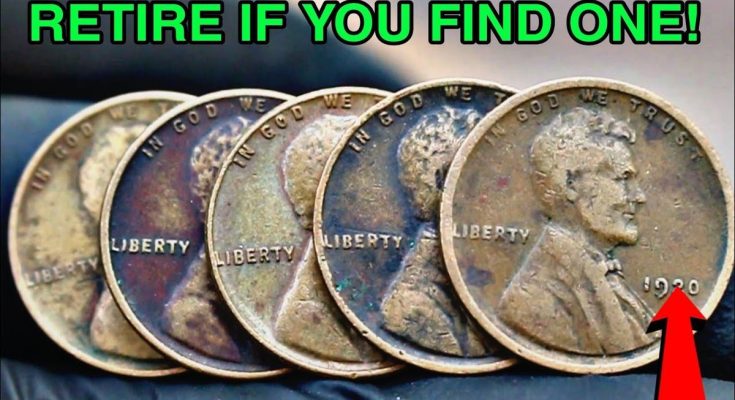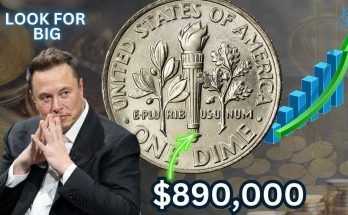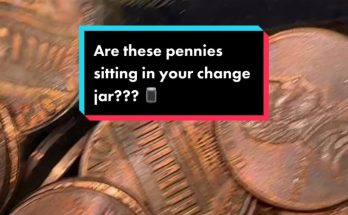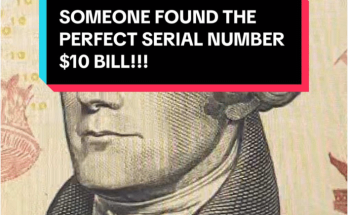The image presents a striking lineup of five Lincoln “Wheat Cent” pennies, their copper surfaces showing varying degrees of oxidation, patina, and wear. The coin on the far right is the most prominent, its features clear, displaying the unmistakable profile of Abraham Lincoln and a visible date: “1920.” A bright red arrow, typical of sensational online content, points directly to this date, drawing the eye to the key identifier of the coin. Above the collection, a bold, all-caps, green banner screams a dream common to every casual coin hoarder: “RETIRE IF YOU FIND ONE!”
This image and its accompanying title—”How Much Can You Sell Your Wheat Pennies For Today Are Your Wheat Pennies Worth a Fortune”—tap directly into the enduring fascination with hidden wealth, the thrill of the treasure hunt, and the belief that a fortune might be lurking in a jar of old pocket change. The Wheat Cent, minted from 1909 to 1958, is perhaps the most iconic American coin still commonly found, making it the perfect vehicle for this kind of numismatic fantasy.
The Wheat Penny, named for the two stalks of wheat that gracefully flank the “ONE CENT” denomination on the reverse side, has a rich history. Introduced to commemorate the 100th anniversary of Lincoln’s birth, it was the first U.S. coin to feature a real person rather than a symbolic figure. These coins were minted during two world wars, the Great Depression, and America’s post-war boom, meaning each piece of copper carries a tangible link to a pivotal era in American history. For many people, collecting Wheat Pennies was their first exposure to numismatics, often filling a small, blue folder with holes waiting to be completed.
The core question posed by the caption—Are your Wheat Pennies worth a fortune?—is complex and highly dependent on a few key factors that the image implicitly asks the viewer to investigate.
1. The Rarity of the Date and Mint Mark: While millions of Wheat Pennies were minted annually, a few specific years and mint mark combinations are indeed valuable. The most famous is the 1909-S VDB, particularly in high condition, which can be worth thousands of dollars. Other rarities include the 1914-D, the 1931-S, and the 1922 “Plain” (no “D” mint mark) Cent, which is actually a valuable error coin. While the prominent coin in the photo is a common 1920 cent (only worth a few cents to a dollar in most conditions), the image plays on the hope that one of the blurred coins in the background might be one of these high-value dates.
2. Condition and Grade: Coin value is profoundly tied to its condition, or “grade.” A common-date penny found in circulation, even if it’s over 80 years old like the 1920 one shown, is typically worth very little above its copper value. However, the same penny preserved in pristine, uncirculated condition (especially with its original “Mint Red” luster) can jump significantly in value. The “RETIRE” claim only applies to coins in the highest grades or those with extremely rare errors.
3. Error Coins: This is where the true “lottery ticket” appeal lies. Rare error coins, such as the 1955 Doubled Die Obverse penny, where the date and lettering appear clearly doubled due to a minting mistake, can sell for tens of thousands of dollars. The sensational caption and banner are specifically aimed at driving people to check their coins for these highly valuable, though incredibly rare, anomalies.
In essence, the image and title are a brilliant piece of clickbait, leveraging a kernel of truth (some Wheat Pennies are worth a fortune) to create a wide net of interest. It encourages viewers to become amateur coin hunters, to look past the coin’s face value and into its history. The reality for 99.9% of Wheat Pennies is a value of a few cents, tied largely to the worth of the copper alloy. But for the collector, the penny represents more than metal; it’s a tangible link to the past, and the faint, enduring hope that in their collection, a single, humble cent might just be the one that pays for retirement.



